The American Film Institute has long been one of the most important leaders not only in film education, but in celebrating and preserving film, television and now digital media. From its annual Life Achievement Awards to film preservation to training new generations of filmmakers at its renowned Conservatory, AFI is indeed an institute to be treasured and supported. But perhaps its crown jewel is the AFI FEST.
Celebrating its 20th year, AFI Fest returns to the Arclight Theater in the heart of Hollywood from November 112, showcasing film works from around the globe in exhibition and competition, with screenings open to the public. This year finds 147 films from 45 countries with everything from International Feature and Documentary Competitions to Latin Cinema to American Directions, African Voices and Dark Horizons. Eclectic, entertaining and often educational, I have already had a chance to screen about 60 of this year’s exhibitors and let me tell you, they are phenomenal. Last year the FEST gave us films like WALK THE LINE and THE LIBERTINE. So, what does 2006 hold? Let’s take a look at some of my faves as the MUST SEE FESTIVAL FILMS for AFI FEST 2006.
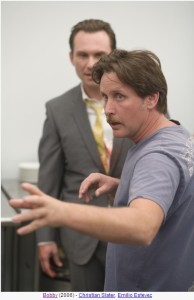 Opening the Festival on November 1 is BOBBY. Written and directed by Emilio Estevez, BOBBY just picked up its first of what I believe will be many awards to come, this one at the Hollywood Film Festival. Concentrating on the day leading up to and night of the assassination of Robert F. Kennedy at the Ambassador Hotel in Los Angeles, this is an ambitious endeavor that revolves around 22 individuals present at the hotel on the final day and in the final hours of Senator Kennedy’s life. As we all know, 1968 was a dramatic and traumatic year of social and political upheaval in our country. From the assassination of Martin Luther King, Jr. to that of Robert Kennedy, the times were volatile and heartbreaking.
Opening the Festival on November 1 is BOBBY. Written and directed by Emilio Estevez, BOBBY just picked up its first of what I believe will be many awards to come, this one at the Hollywood Film Festival. Concentrating on the day leading up to and night of the assassination of Robert F. Kennedy at the Ambassador Hotel in Los Angeles, this is an ambitious endeavor that revolves around 22 individuals present at the hotel on the final day and in the final hours of Senator Kennedy’s life. As we all know, 1968 was a dramatic and traumatic year of social and political upheaval in our country. From the assassination of Martin Luther King, Jr. to that of Robert Kennedy, the times were volatile and heartbreaking.
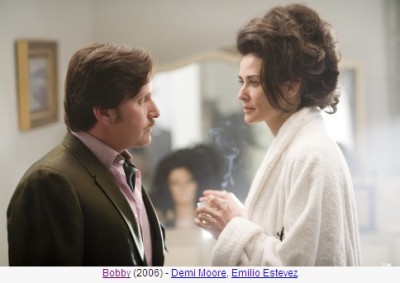 Interspersing actual newsreel images from the period, Estevez intricately weaves a tapestry of storied lives all drawn together at the Ambassador Hotel on that fateful night in June 1968. Using the technique of expertly crafted and edited narrative vignettes, Estevez creates characters from all walks of life someone for everyone to relate to and something that really demonstrates the vast appeal of Kennedy. Setting the political stage is short lived before the film moves full swing into the fictional stories. From doormen to drunken lounge singers to socialites, starlets and dishwashers, almost every walk of life and ethnicity is represented.
Interspersing actual newsreel images from the period, Estevez intricately weaves a tapestry of storied lives all drawn together at the Ambassador Hotel on that fateful night in June 1968. Using the technique of expertly crafted and edited narrative vignettes, Estevez creates characters from all walks of life someone for everyone to relate to and something that really demonstrates the vast appeal of Kennedy. Setting the political stage is short lived before the film moves full swing into the fictional stories. From doormen to drunken lounge singers to socialites, starlets and dishwashers, almost every walk of life and ethnicity is represented.
The cast reads like a Who’s Who of Hollywood boasting A, B and C list stars. Sir Anthony Hopkins as retired doorman John Casey is stellar as is Demi Moore as the drunken lounge singer Virgnia
Fallon who is appearing at the Ambassador that fateful night. Abusive to her husband, interestingly enough played by former reallife flame, Emilio Estevez, Moore gives a fascinating performance. Not to be overlooked are Sharon Stone, Harry Belafonte, Freddy Rodriguez, Christian Slater, Helen Hunt and Martin Sheen. And as a draw for the younger generation, exemplary performances rise from Lindsay Lohan, Joshua Jackson and Elijah Wood. But the crowning performance comes from William H. Macy as hotel manager Paul Ebbers. Look for Oscar to come knocking at Macy’s door, among others in this film, come February.
I was awed by the thought and meticulous detail Estevez put into not only the script and its di
alogue, but the filming itself. Shot on location at the Ambassador Hotel during its razing, the film embodies history. Impressive to a fault is the work of production designer Patti Podesta who brought the Ambassador back to its original grandeur for filming. And cinematographer Michael Barrett should also grab an Oscar nod for his work. Using a Steadicam for the majority of filming, Barrett and Estevez are able to seamlessly blend current footage with archival, giving a documentary feel to the project.
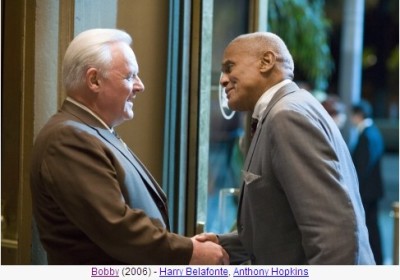
BOBBY is without a doubt a MUST SEE FILM at AFI FEST 2006.
Making its World Premiere as part of the American Directions Category is BIG DREAMS LITTLE TOKYO. Reviewed by me in full last week, BIG DREAMS LITTLE TOKYO is absolutely charming.
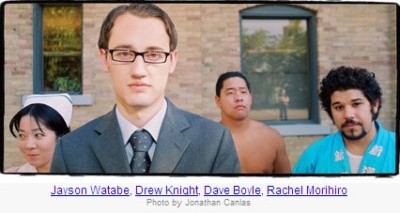
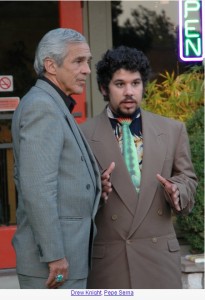 This is the story of Boyd and Jerome and their “big dreams.” Boyd is an American enamored with the Japanese – their way of life, their language, their customs, their dreams. Aspiring to be a successful Japanese businessman his biggest obstacle is himself. Viewed as an outsider to his target Japanese audience, he has more than a little trouble in pursuing his dreams. And meet his roommate Jerome. Japanese-American, Jerome believes himself to be too American to be Japanese and too Japanese to be American. A fish out of water, Jerome dreams of being a Sumo wrestler. Sadly, he too, faces obstacles. A tad on the small side, he needs to pack on the pounds before even coming close to Sumo status, but he also has to consider other medical issues like high blood pressure that put him in the ER every time he gains some weight.
This is the story of Boyd and Jerome and their “big dreams.” Boyd is an American enamored with the Japanese – their way of life, their language, their customs, their dreams. Aspiring to be a successful Japanese businessman his biggest obstacle is himself. Viewed as an outsider to his target Japanese audience, he has more than a little trouble in pursuing his dreams. And meet his roommate Jerome. Japanese-American, Jerome believes himself to be too American to be Japanese and too Japanese to be American. A fish out of water, Jerome dreams of being a Sumo wrestler. Sadly, he too, faces obstacles. A tad on the small side, he needs to pack on the pounds before even coming close to Sumo status, but he also has to consider other medical issues like high blood pressure that put him in the ER every time he gains some weight.
An odd couple to say the least, Boyd and Jerome are not only the definition of “culture clash” but shining examples of heart and soul. Using the gimmick of teaching English to Japanese as well as hawking the best English instructional manual in the business, Boyd’s sticktuitiveness is commendable and infectious – okay, and it’s not a bad system for picking up a pretty little nurse named Mai, either! Meanwhile, continually clad in his mawashi (aka Sumo diaper), Jerome keeps on pushing like the Little Engine that Could, not only to pursue his Sumo dream, but to find a sense of self and “like kind”, some kindred spirits. At the very heart, what Boyd and Jerome both long for is to just fit in, “be somebody” and fulfill their dreams.
 Written and directed by newcomer David Boyle, Boyle (who also stars as Boyd) draws on his own experiences as a Mormon missionary in Sydney, Australia. With a believable sincerity, Boyle pulls on the heart strings taping into not just culture clash, but the commonality we all share – dreams and the journey to discovery who we are and where we each belong in the grand scheme of things. Meshing nicely with Boyd’s Boyle is newcomer Jayson Watabe. Suiting up as Jerome, he does so with an apparent joy. His inexperience, however, does show, but given the nature of the film and the foibles of self-exploration, big dreams and the modern world, it works to his
Written and directed by newcomer David Boyle, Boyle (who also stars as Boyd) draws on his own experiences as a Mormon missionary in Sydney, Australia. With a believable sincerity, Boyle pulls on the heart strings taping into not just culture clash, but the commonality we all share – dreams and the journey to discovery who we are and where we each belong in the grand scheme of things. Meshing nicely with Boyd’s Boyle is newcomer Jayson Watabe. Suiting up as Jerome, he does so with an apparent joy. His inexperience, however, does show, but given the nature of the film and the foibles of self-exploration, big dreams and the modern world, it works to his
advantage for the most part. And Rachel Morihiro lends a sweetness to Nurse Mai, the object of Boyle’s affection.
Boyle is a natural storyteller and given his life experiences, has many stories to tell. Here, the script’s strength comes from this experiences which he melds together by interweaving characters and cultures. Knowing that this film is character and story driven, as a director Boyle keeps his eye on the ball and keeps his direction clean and simple; nothing technically impressive or out of the ordinary to detract. And while this story could be told against a backdrop of any two or three cultures with a similar result, Boyle’s experience with the dichotomous “East meets West” is enchanting.
A large part of the humor and charm of this film comes from character interaction and response to situations and particularly, Boyd’s business efforts. A picture truly is worth a thousand words and here, the pictures are priceless. It is with these laced vignettes and personal experiences that Boyle connects with each of us.
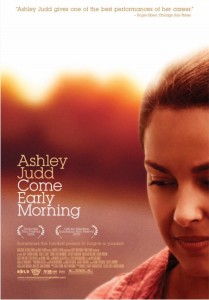 Fast becoming a festival favorite is one of my long time favorites, Ashley Judd. With two films in the Fest, both are must sees. First up is COME EARLY MORNING. Debuting at the Fest and opening in limited release on November 10, 2006, this is the story of a young Southern woman named Lucy. Fraught with fear of relationships, a contractor by day, she is committed to drunken onenight stands at night, often waking up not knowing where she is or who she is with. Written and directed by Joey Lauren Adams, in her directorial debut, Adams draws from her own experiences growing up in the South. And while the film touches on Southern sensibilities, it has something that will connect with everyone from or familiar with rural and small town America. The film as a whole not only reminded me of my own visits down South to Omaha, Georgia with my beloved devoutly religiously aunt and her pink doublewide trailer, but it also connected with little towns like Browns Mills, New Jersey.
Fast becoming a festival favorite is one of my long time favorites, Ashley Judd. With two films in the Fest, both are must sees. First up is COME EARLY MORNING. Debuting at the Fest and opening in limited release on November 10, 2006, this is the story of a young Southern woman named Lucy. Fraught with fear of relationships, a contractor by day, she is committed to drunken onenight stands at night, often waking up not knowing where she is or who she is with. Written and directed by Joey Lauren Adams, in her directorial debut, Adams draws from her own experiences growing up in the South. And while the film touches on Southern sensibilities, it has something that will connect with everyone from or familiar with rural and small town America. The film as a whole not only reminded me of my own visits down South to Omaha, Georgia with my beloved devoutly religiously aunt and her pink doublewide trailer, but it also connected with little towns like Browns Mills, New Jersey.
Believable to a fault. The dialogue is right on point with the time, the era and the Southern lifestyle. Yet, the story is one that everyone can relate to in some fashion.
The cast is outstanding. Ashley Judd is the epitome of emotion and no one plays a strongwilled woman with an innocent vulnerability better than she. She does the slutty aspect of the character well, too, although I thought that emotion and portrayal was a bit too similar to that of her character in “Twisted.” Diane Ladd steps in as Lucy’s grandmother and is, of course, wonderful with her down home sarcastic wit while veteran Pat Corley takes the reins as Lucy’s grandfather. Not to be outdone, Adams even wrangled Stacy Keach to come on board as Lucy’s boss, Owen. Rock solid, Keach’s turn as Owen bodes well as a calming influence and beacon of light to Judd’s Lucy. It was also a joy to see Scott Wilson as Lowell Fowler. Probably best known of late as casino owner Sam Braun on “CSI”, his turn her as Lucy’s father Lowell is a side of Wilson not that familiar to us. And why haven’t we heard more from Jeffrey Donovan? As love interest Cal, he is the exemplification of every Southern mother’s dream of a genteel polite young man that is until the tables turn and personality reversals and growth take shape.
Although a bit tedious at points, I can understand Adam’s choices in her direction and pacing. While it bodes well with the theme of the film, some may get a bit antsy with some of the more drawn out sequences. A beautiful character study acted superbly, COME EARLY MORNING is an uplifting winner.
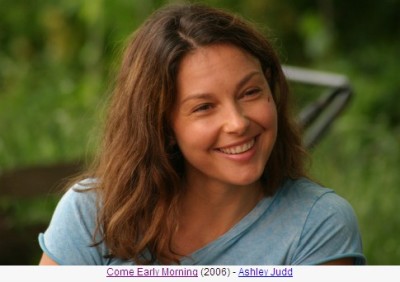
Another American Directions contender is FULL GROWN MEN. Directed by David Munro and written by Munro and Xandra Castleton, this is the story of Alby, a 38 year old who seems to have contracted that “disease” running rampant among the 3040 something men of America today going beyond nostalgia, and even beyond the Peter Pan phenomena, this is a never grow up situation that entails physically growing up, marrying, getting a job (for some), having kids, the house, the two cars, but doing so as merely going through the motions without the emotional conceptualization of what growing up or life itself entail; and often with disastrous consequences. Lucky for us, Munro captures it all but with a zany fun perspective.
Enjoyable, funny, believable, and although it has serious (and very true) undertones, is hopeful, upbeat and “connectable” to everyone. Taking his collection of pristine action figures with him, Alby runs away from home and goes back to his mother who suffers from Alzheimer’s. Determined to stay a child forever, he leaves his wife and young son (aka playmate) seeking sanctuary at his childhood home.
Completely morphing into his childlike self, Alby seeks comfort in his “best friend in the whole world” Elias. One little thing Elias is now a teacher, grown up, accepting responsibility, embracing responsibility. Life, and Elias, have moved on. But, Alby sparks something in Elias that has him yearn for a little bit of the boy he once was and it’s not long before the two are on the road to Diggityland Elias to get a Teacher of the Year Award and Alby, well, just to goof off and hide. Needless to say, their adventures along the way prove to be some valuable lie lessons for them both.
Set in South Florida, a more ideal location, Munro could not have selected. Long having an image as being a playground for retirees and springer breakers alike, this is the perfect playground for Alby. Visually, the film is more than effective. With retirees giving Alby some sage advice that isn’t done in a preachy manner, maturity rears its ugly head with a sweet kindness. You can’t help but laugh at these old geezers riding around on bikes in their shorts and socks with sandals, goofy hats on their heads, etc., which just goes to further perpetuate the theme of the film and if Alby (and the audience) looks hard enough, gives some insight into what the future will be like if he doesn’t get with the program and act 38 instead of 8. This is one of the few films I have seen the past month or so (and based on what’s releasing in the next 60 days) that actually doesn’t leave you depressed or suffering from the doldrums when the credits finish.
Matt McGrath stars as Alby. I first took notice of him in “The Notorious Bettie Page” but I must say, I am more than impressed with him here as Alby. Complimenting McGrath’s juvenality is Judah Friedlander who is joyous as Elias. His interpretation of the character really aids in setting forth the juxtaposition and dichotomy of the lives and mentalities between the two. And pay special attention for two casting coups – Alan Cumming and Deborah Harry are absolute flashes of brilliance for casting ….Alan Cumming equating the little toy solider action figures come to life and Deborah Harry as the Little Mermaid or Barbie as a female connective of playing with dolls. And the nostalgic value of Deborah Harry great!
The icing on the cake is comic animation at the end that is absolutely adorable and so befitting the film. Nice touch by Munro.
I was dying to see this film and am so glad I did. It proved to be even more than I hoped. Witty, wise and wacky!!
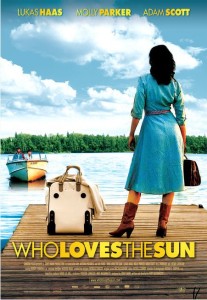 Festivals and Lukas Haas seem to go hand in hand. From Gus Van Sant’s “Last Days” to Derek Sieg’s “Swedish Auto”, Lukas is a familiar and welcome face on the festival circuit. Charming, polite, talented, diverse, I know going in that a film with Lukas Haas will be a winner. And WHO LOVES THE SUN is no different.
Festivals and Lukas Haas seem to go hand in hand. From Gus Van Sant’s “Last Days” to Derek Sieg’s “Swedish Auto”, Lukas is a familiar and welcome face on the festival circuit. Charming, polite, talented, diverse, I know going in that a film with Lukas Haas will be a winner. And WHO LOVES THE SUN is no different.
Lukas Haas plays Will Morrison. A loner, Will returns to his childhood home after a mysterious absence of over years. After walking in on best friend David and his wife Maggie, will disappeared. Just as strange as his disappearance, however, is his reappearance when out of the blue he appears, intent on “surprising” his Daniel. Seems in the past few years, Daniel has made quite a name for himself. With a best selling novel and steady income writing for a New York magazine, David is the toast of the town. Will, however, is still a loner with a lost sadness about him.
The acting is first rate. Full bodied, realistic and sincerely wicked at times, be it Haas or Adam Scott as Will’s foil Daniel Bloom or Wendy Crewson as Daniel’s wife Mary, they all shine. Haas is impeccable and with his own patented brand of inner brooding, keeps the audience – and the characters – on their toes, guessing who and what he is all about. And as he always seems to do, he effortlessly grows and transforms the character right before your eyes. Lukas is always compelling and interesting to watch. Crewson, perhaps best known from her days as Tim Allen’s wife in “The Santa Claus” is magnificent. But it is Molly Parker as Will’s ex that steals the show.
Written and directed by Matt Bissonnette, there is a dry irony and subtlety wielded rapier wit to the story that permeates the characters. Well known to the indie crowd, cinematographer Arthur E. Cooper gives the film a lushness that befits the rustic woodsy setting and gives the film a visually pleasing fluidity that ebbs and flows with the story.
Sweet and touching with a razor wit, you can’t help but love WHO LOVES THE SUN.
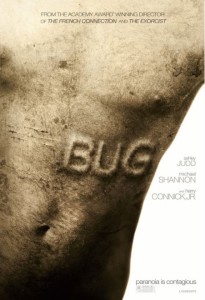 And what would a film festival be without some horror. I know my life wouldn’t be complete with it and this year, AFI corners the market with some outstandingly horrific – and hysterical – entries!
And what would a film festival be without some horror. I know my life wouldn’t be complete with it and this year, AFI corners the market with some outstandingly horrific – and hysterical – entries!
First, we have BUG. Written by Tracy Letts based on her acclaimed Broadway play, BUG marks William Friedkin’s return to horror. Yes, this is THE Friedkin as in “The Exorcist.” Ashley Judd stars in this emotionally infested portrayal of Agnes, a down and out barmaid who calls a squalor of a motel room home. A victim of domestic violence, her beloved ex now safely behind bars, Agnes masks her pain and her past with alcohol and drugs, hiding in her own little roach motel.
Enter Peter. A drifter. Seems nice. Seems sweet. He gets under Agnes’ skin and she begins to open up and start to care about Peter, life and herself. But that bit of joy is short lived because it’s not long before that swell of a guy, ex-husband Jerry, rears his ugly head. Released on parole, Jerry reappears, vowing undying love and that he is a “changed man.”
But Jerry isn’t all that claims change. Peter goes through his own metamorphosis after seeing a bug in Agnes’ motel room – quite conveniently after one of their romantic interludes.
Needless to say, Ashley Judd is impeccable as Agnes. Broken, tormented and emotionally scarred, but with an innate core of inner strength, as I said before, no one does this type of character better than Judd. And while Michael Shannon is admirable as he reprises his stage role as the sweet but bizarre Peter, it is Harry Connick, Jr. that soars with his minimal screen time as Jerry.
Letts does a fine job of adapting her play for the screen. With multitextural characters, including the motel room itself, the story is so dementedly compelling so as to command repeated screenings. This is definitely a film I will buy on DVD to watch over and over and over again.
Lurking like a spider dangling from its web in the corner of the room, Friedkin envelops you and creates an almost claustrophobic fear. Low budget but with high production values, much of the credit for this achievement goes to cinematographer Michael Grady. I was notably impressed with Grady’s work in last year’s “Wonderland” and he once again more than lives up to the challenge presented with Letts’ screenplay and Friedkin’s interpretation.
Despite an unevenness to the story and the fact that it lends more to a psychological drama than horror, there is an overall darkness to BUG that shouldn’t be missed.
Moving into a more comedic horror situation, a competitor in the Dark Horizons Category is ALIEN AUTOPSY. Based on the true story of a pair of Brits who make a film depicting their “autopsy” of an alien in Roswell, New Mexico, this is a not-to-be-missed horror mockumentary. For those of you that may recall the news item and the original hoax as it aired on the Fox TV Network in 1995, be warned – the truth may be out there but, here, you 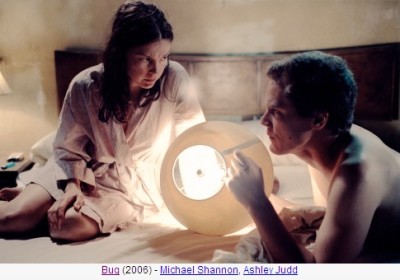 can’t believe what you see – at least not with ALIEN AUTOPSY.
can’t believe what you see – at least not with ALIEN AUTOPSY.
Ray Santilli and Gary Shoefield are at the top of the charts on British television. Enter documentary director Morgan Banner. Established as a leader in documentary in the US, Banner and his crew visit Santilli and Shoefield for a secret interview on their “experience.”
Based on their “true story” Ray and Gary head to the States for purposes of hooking up with a man named Harvey who claims to have a non-copyrighted piece of film footage – an autopsy on an alien at Roswell in July 1947. Allegedly Harvey was in the military and participated in this most secret-of-secret alien autopsy.
Seeing the monetary potential in such a rare piece of history , the boys manage to come up with the $30,000 price tag (compliments of a Hungarian loanshark) for the autopsy film but you know that old saying, caveat emptor – let the buyer beware. Without batting an eye or looking at piece of celluloid, the boys hand over the cash to Harvey and rush back to England with their gold mine. Sadly, when they finally decide to look at the footage, it comes up blank.
Not wanting to find themselves in cement shoes or wind up like Jimmy Hoffa, Ray and Gary have a brainstorm – let’s make our own film of an alien autopsy! Let’s face it folks – all the synapses aren’t firing with these two. With the help of a kebab salesman named Melik and his girlfriend Jasmine, the group puts together a film acceptable and believable enough to loanshark Laszlo who in turn sells the film to international tv. Needless to say, the laughs take hold when the autopsy hits the open market.
Bill Pullman stars as documentary director Morgan Banner while Declan Donnelly and Ant McParlin take on Ray and Gary, respectively. Pullman is enjoyable enough but don;’t look for anything too inspiring from Donnelly and McPartlin. Omid Djalili as Melik, however, is an absolute scream. The real Ray and Gary also turn up in cameos.
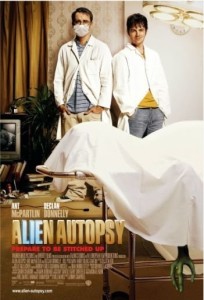 Director Jonny Campbell brings his years of British television experience to the table and does a more than adequate job with the lensing of the film. Using a grainy technique, it bodes well for the mockumentary type project at hand. Although there are some glaring holes in the script and mockumentary style holds fast giving a comedic look at a pull-the-wool-over-the-eyes-of-the-world grifting of a perceived “horror.” Funny and entertaining although far from an X-File, you gotta see this ALIEN AUTOPSY.
Director Jonny Campbell brings his years of British television experience to the table and does a more than adequate job with the lensing of the film. Using a grainy technique, it bodes well for the mockumentary type project at hand. Although there are some glaring holes in the script and mockumentary style holds fast giving a comedic look at a pull-the-wool-over-the-eyes-of-the-world grifting of a perceived “horror.” Funny and entertaining although far from an X-File, you gotta see this ALIEN AUTOPSY.
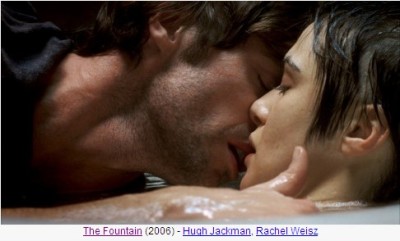 Hugh Jackman and last year’s Best Actress Oscar winner Rachel Weisz, come together in the poignant THE FOUNTAIN. Selected as AFI’s Centerpiece Gala Selection, THE FOUNTAIN is written and directed by Darren Aronofsky. Last helming “Requiem for a Dream”, Aronofsky now brings to life man’s 1000 year old quest for the elusive Fountain of Youth.
Hugh Jackman and last year’s Best Actress Oscar winner Rachel Weisz, come together in the poignant THE FOUNTAIN. Selected as AFI’s Centerpiece Gala Selection, THE FOUNTAIN is written and directed by Darren Aronofsky. Last helming “Requiem for a Dream”, Aronofsky now brings to life man’s 1000 year old quest for the elusive Fountain of Youth.
Traveling through the annals of time, Jackman and Weisz assume the roles of multiple characters set in different periods of history. We initially meet 16th Century Tomas as he nears his goal of finding the Tree of Life. With his quest cut short by a fire branded sword, time fast forwards and we see Jackman now as Buddha dreaming of an angelic woman named Izzi.
Cut to present day and Jackman is Tom Verde, M.D. Married to the beautiful Izzi, we quickly learn that she is dying of an inoperable brain tumor. Determined to save the love of his life, Tom uses experimental drugs formulated from a Souther American tree bark on a monkey in the hope of finding a cure for Izzi. Bereft and berating is Lilian, Tom’s team leader from his treks to South America, who has nothing hopeful or kind to say, even as the monkey starts to make an unusual recovery. Not only is the monkey’s like tumor decreasing in size, his cells and organs appear to be regenerating, growing more youthful with every passing hour.
Facing her own mortality, Izzi has put her last days to good use. She has penned a novel called “The Fountain”, leaving the final chapter for Tom to complete on her passing.
Fueling the age old debate of life and death, the emotional and intellectual struggles set forth are heart-wrenching and thought provokingly intriguing. A tacit strength permeates the characters and Jackman and Weisz are mesmerizing. Could we be looking at a second Oscar nod for Weisz? I wouldn’t be surprised.
Visually stunning, the emotional narrative propels us into an introspective self-analysis that will have the audience talking long after the film’s end. Although some may find the ping-pong time travels as distracting or even annoying, this is definitely my pick as the most beauteous and emotionally exquisite film of the Festival. THE FOUNTAIN speaks volumes.
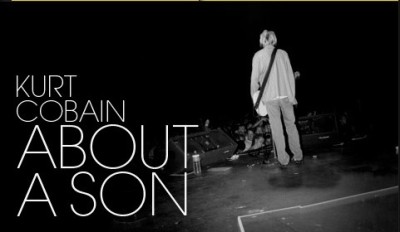 Turning our attention to documentaries, KURT COBAIN: ABOUT A SON is one of the top contenders in the International Documentary Competition. Within the past week, Cobain became the highest grossing entertainer in death and this documentary gives a little insight into Cobain’s popularity and connection with the masses to this day.
Turning our attention to documentaries, KURT COBAIN: ABOUT A SON is one of the top contenders in the International Documentary Competition. Within the past week, Cobain became the highest grossing entertainer in death and this documentary gives a little insight into Cobain’s popularity and connection with the masses to this day.
Directed by AJ Schnack, the film is inspired by some 25 hours of interviews conducted by journalist Michael Azerrad with Cobain in 1993, one year before his untimely suicide. Setting interviews to well placed visuals and well-paced music, Schnack tracks Cobain’s life from a childhood with an abusive father through his success with Nirvana. The audience is made to feel as if privy to the inner workings of Cobain – his thoughts, what made him tick, his emotional highs and lows. A manic depressive, Cobain was a loner throughout his youth and plagued with medical problems involving his back and stomach, which come through as being some of the strongest affects on his life – and death.
Clearly devoted to, enamored and in love with his wife, Courtney Love, director Schnack gets this sobering and humanizing point about Cobain across. Thanks to a combination of inspiring black and white photos by Charles Peterson with a color compliment by cinematographer Wyatt Toll, Cobain’s legacy is kept in the forefront and with this film, given a voice to an entirely new audience. A rarity today, the film is shot in 35mm.
But for me, the strongest showing in the International Documentary Category comes from BACK HOME, the true story of J.B. Rutagarama.
Escaping Rwanda years ago, J.B. now travels back to his native land in search of his family and the life he once knew. Returning to his birthplace, J.B. meets up with old friends and learns of fates one should never have to face. Heart wrenching and dramatic, what we see is what is left of his past, and the hope and humanity the Rwandans now have, following the Rwandan genocide.
Lensed through JB’s eyes, the film is personalized with an eloquent simplicity. Juxtapositioning the beauty of Rwanda against the horror and terror of war, JB allows us to feel the loss, the terror and the horror that he and his surviving friends and family felt, and still feel. Faced with adversity from start to finish in the making of this film, JB persevered despite the military seizing both his cameras and film, and having his relative tell their stories, a feat which was long delayed due to the trauma from which they still suffer and which long kept them from recounting the atrocities they witnessed and suffered.
There are no words to describe the emotion of this film. I can only guarantee there won’t be a dry eye in the house when the curtain falls on BACK HOME.












